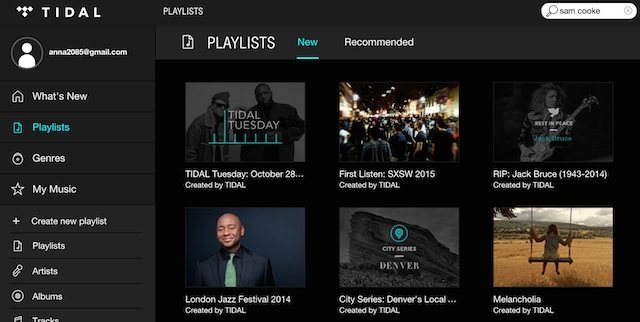
As hi-rez listening solutions continue to pop up (Neil Young’s Pono Music being the best-known), RAIN senior writer Anna Washenko test-drove the newly launched Tidal streaming platform from European company Wimp. It costs twice as much as other on-demand services ($20/month). Is it worth it?
WiMP has attracted a large European audience, and now it has expanded into the U.S. and UK with a new Hi-Fi service called Tidal. We tested it out to hear for ourselves whether the new trend of lossless streaming would offer a vastly improved experience.
Getting In
Things got off on a bad foot with a big red error message appearing after signing up for a free trial. Once we did finally log in, the interface didn’t make clear that we couldn’t dive right into listening. After finally getting into the library, we tested the service on the web player and the Mac app, listening on Grado headphones.
Listening
We listened to songs across several genres and time periods to listen for where the lossless files would yield a vastly different audio experience. Folk and jazz songs yielded the best improvement. The Carolina Chocolate Drops sounded clearer in the percussion and guitars, the vocals more crystalline and nuanced. It was like being in the same room with them. A track by Wynton Marsalis captured the same reverberations and immediacy. The bass notes in particular had more life, but that was true across all genres.
The biggest differences we heard were in cases where the song had enough empty space to hear that extra twang of a bass string or the full ring of a piano key. A fully-produced wall of sound on Tidal offered a little more range than you’d hear from the same track as an MP3, but nothing that wouldn’t already be lost if listening with cheap headphones. Switching between the Normal and HiFi settings didn’t yield an obvious improvement in sound quality. At one point, in the middle of a new rock playlist, the app displayed an error message that read “We are experiencing HiFi playback problem.” We probably wouldn’t have noticed without happening to look at the app.
Library and Visuals
Another hit against the service is Tidal’s limited library. We found all the artists we looked for, but the album selection often didn’t include the full catalog. For instance, we looked for Moby to test out some electronica, but couldn’t find his big early album “Play.”
On the visual side, the features are similar to most other playlisting services. There are artist pages with brief bios, related artists for browsing, and drop-down menus for song collections. The app and web players don’t look that similar. The white and gray app looks like a previous iteration of iTunes, but the web player took its cues from the dark tones of Spotify. Our personal preference is for the easy-on-the-eyes experience of the web player. We also found it odd that for a service that’s aiming for luxury, the app does not meet Apple’s Retina resolution.
Conclusion
Our assessment is that if you’re somebody who has always eschewed digital in favor of vinyl, this will probably be a good service for you. If you’re only listening on earbuds, Tidal won’t be worth the price. That said, everyone’s ears know what they like, so take a free trial spin if you’re curious about whether you’ve been missing out on new worlds of sound.

